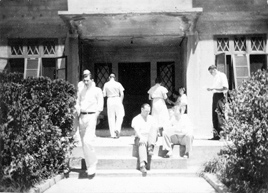1936: Excitation Phenomena, Vol. IV
Organizer: Eric Ponder
The new director of the Biological Laboratory was Eric Ponder, a biophysicist interested in the properties of cell membranes. He used the red blood cell as a model system and hoped to learn something of the nature of the membrane by its response-as measured by lysis-to different chemicals. He published extensively on this topic, as well as writing a monograph, The Mammalian Red Cell.
It is not surprising, then, that Ponder continued the line of topics initiated by Harris, and, in fact, devoted the fourth Symposium to a topic that had formed but one part of the first Symposium. Much of that meeting—on Surface Phenomena—had dealt with the electrical properties of membranes and related phenomena such as the flow of ions across cells. At this time, electrophysiology exemplified the quantitative, biophysical studies that many researchers believed were the future of biology. And so the whole of the 1936 Symposium was on the electrophysiology of nerve and muscle. As Ponder put it in the Annual report, this was a "...subject upon which physiologists, chemists and physicists can meet upon common ground and suggest future lines of research to each other."
It was an opportune time for the meeting. In the opening presentation, J. Z. Young described his anatomical studies of the nerves of the Atlantic Squid and announced his discovery (actually rediscovery of findings made some twenty years earlier) that the nerves supplying the muscles of the mantle are enormous-as much as 1mm
| 
in diameter. Cole and Curtis put these nerves to good use in electrophysiological studies in the following year and two years later Hodgkin and Huxley developed the remarkable technique of inserting an electrode within the nerve fiber (See Symposium XVII The Neuron, 1952).
The Symposium was notable for an exchange over the workings of the neuromuscular junction, between the chemical theory of transmission (Dale, Loewi, and Feldberg) and the physical theory in which the nerve action potential is transmitted directly to the muscle (M. Lapique). Dale had detected acetylcholine only four years earlier and the electrophysiologists were continuing to fight a rear-guard action against the idea that a chemical was needed to mediate between nerve and muscle. Dale made a contribution to the Symposium but unfortunately did not attend in person.
The meeting was well attended with fifty-four participants, although with visitors the number attending rose as high as seventy. Thirty-six papers were presented, three of which were communicated by mail. — Jan A. Witkowski |